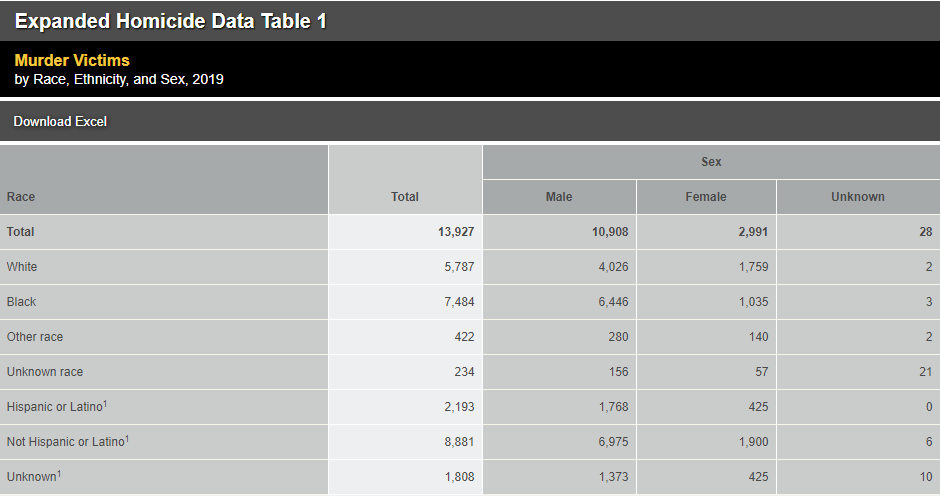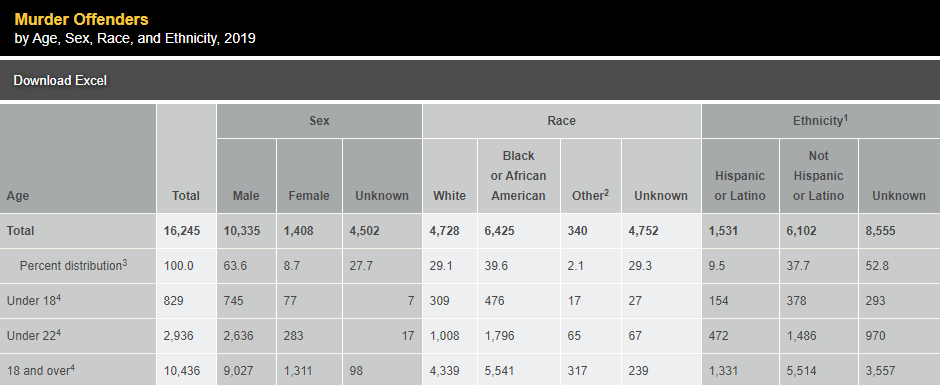According to FBI statistics, the crime rate in the United States is growing. In the early 2000s, it declined significantly, especially in the number of homicides and other serious violent crimes (Federal Bureau of Investigation, 2019). However, in recent years, the murder rate has risen significantly across the country, and some states have much higher levels of violent crime. Using data from the Uniform Crime Report, this paper discusses the peculiarities of the homicide rate in the United States and its changes over time. The analyzed data represents the actual prevalence of homicide in the country and may influence the decision-making process in developing policies to minimize this crime.
In 2019, the number of homicides in the United States was 16,245. In 2020, the situation has deteriorated and murders have increased by an average of 24 percent compared to 2019 (Federal Bureau of Investigation, 2019). As Figure 1 states, the homicide rate has risen by 0.3 percent from 2018, by 3.4 percent from 2015, and by 11.6 percent from 2010 (Federal Bureau of Investigation, 2019). In 2020, 41 mass murders have been committed in the United States so far (Bullinger et al., 2020). American public attention was drawn to the mass shooting in El Paso and Odessa, Dayton, Virginia, and New Jersey. In the passing year, the highest number of massacres was committed in the United States since the 1970s when the country began to record the crime rates.

The largest surge of violence occurred in Chicago where the biggest number of all murders was recorded. Moreover, compared to 2019, the number of homicides in Chicago has grown by more than 50 percent (Bullinger et al., 2020). According to the Chicago Police Department, from January 1 to the end of July 2020, 440 murders were committed in Chicago, and a total of 2,240 people received bullet wounds, including fatal ones (Bullinger et al., 2020). Chicago police say that the high numbers are linked to gang wars when members of a rival gang are shot from a passing car, and random bullets also hit passers-by. Homicide rates have also increased in both typically high crime cities such as Detroit and Philadelphia, as well as generally peaceful cities such as Phoenix and Omaha. New York has also seen a surge in crime and gunfire in 2020.
The highest number of massacres occurred in California, the state with the strictest rules for carrying and acquiring firearms. In most cases, the attackers were personally acquainted with their victims. This happened in the case of family quarrels, wars between criminal gangs, or shootings caused by anger and irritation towards colleagues or relatives. At the same time, in many cases, the motives that guided the attackers were never revealed. In general, Michigan is considered the most dangerous state because of the most criminal city of Detroit (Bullinger et al., 2020). Today, some other states can be distinguished, such as Arkansas, Missouri, California, Tennessee, New York, and Ohio.
Taking into account race and gender, black men seem to be most victimized by homicide in the United States. According to the Uniform Crime Report, in 2019, most of the murder victims were males. Based on the Expanded Homicide Data Table 1, it can be calculated that 46 percent of all homicide victims were African American men (Federal Bureau of Investigation, 2019). Violence is directed primarily at members of the same racial or ethnic group. Therefore, the number of murder victims per 1 million inhabitants among African Americans is much higher than among whites, Hispanics, and Asians (Federal Bureau of Investigation, 2019). White homicides are distributed relatively proportionally across different demographic groups. In contrast, murders committed by blacks focus on members of their racial group. The distribution of the death toll of African Americans by race or ethnicity of the criminal highlights the leading cause of violent deaths among black Americans.

Another distinctive feature that characterizes American crime is the ethnicity of the offenders. In 2019, 39.5 percent of African Americans committed a homicide in comparison with 29.1 percent of white people (Federal Bureau of Investigation, 2019). However, white nationalists are also responsible for the vast majority of all extremist killings over the past 10 years. In 2018, that number soared to 78% of the total homicide rate (Federal Bureau of Investigation, 2019). According to the Expanded Homicide Data Table 3, 88 percent of the offenders in 2019 were males (Federal Bureau of Investigation, 2019). Thus, black males appear to be the offenders most of the time. Criminologists associate this tendency with discrimination against black people, who find it difficult to have permanent work and housing, which pushes them onto the criminal road.

The crime rate in the United States is high because the influence of gangs is still great. The total number of gang members in the country, despite serious opposition from the police, is large and amounts to about 1.4 million people (Federal Bureau of Investigation, 2019). In some cities, there are areas where even police officers are afraid to go unarmed. Another important factor is the role of firearms in homicides. Since it is officially allowed to carry firearms for self-defense, on the one hand, it allows people to protect themselves as much as possible. On the other hand, it leads to frequent fatal shootings, which negatively affects the overall security of the United States.
The growing number of murders should lead to a reassessment of the internal threat posed by black gangs and militant white nationalists. The use of regulations that severely restrict the rights of citizens to own firearms can lead to a decrease in the level of homicide and other violent crimes. Congress tried to impose mandatory identity checks on all weapons purchases, including private transactions. Despite Senate support, the project was blocked by a minority over procedural objections. Today the situation is changing since Congress has passed legislation regulating the possession of firearms. However, the opposition to any gun control bills in the Senate remains significant.
The existence of dangerous gangs, racism, and the availability of firearms significantly undermines the security of the United States. Recently, many of the murders have been committed against members of racial and ethnic minorities. In each of these cases, the offenders were guided by their conviction that the representatives of other races were going to harm them. The provided figures give rise to many politicians to declare that it is time to end the growth of homicide since it is the result of incorrect shifts in the public perception of crime. This threat should lead to effective methods and procedures of dealing with this issue, including the reduction of racist attitudes and increased gun control.
References
Bullinger, L. R., Carr, J. B., & Packham, A. (2020). COVID-19 and crime: Effects of stay-at-home orders on domestic violence. National Bureau of Economic Research.
Federal Bureau of Investigation (2019). Uniform Crime Reports. 2019 crime in the United States. Web.